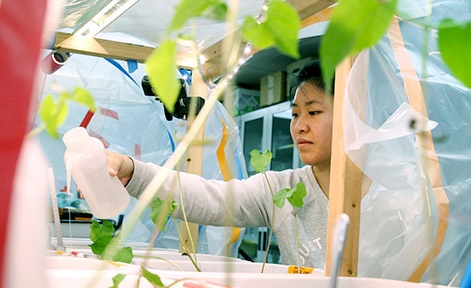
By James Marien —
This year, NASA has released several discoveries about the red planet, from atmospheric data to the characteristics of the soil. Extremely enthused about the latest Mars mania, University of Wisconsin–Stout students, professor of biology Amanda Little and professor of physics Matt Kuchta are contributing to the investigation. Kuchta and Little are offering evidence that life can grow on Mars.
Inspired by the film, “The Martian,” the project tries to stay as true to the conditions of the movie as possible. The main character, played by Matt Damon, survives alone on Mars by gardening the soil of the planet. Normally, Martian soil would be unable to provide sustenance to plants due to the lack of nutrients, which typically comes from organic material. However, in “The Martian,” the lonesome astronaut creates a closed environment, adds organic material to the soil and cultivates a thriving garden.
Suspicious of movie magic, Kuchta and Little, who are both teaching courses that examine soil, sought out to discover the truth behind Martian soil. They created their own Martian soil with 400 pounds of glacial subsoil from local Chippewa County. This subsoil, which lies under topsoil, is the most similar to Martian soil in the Midwest due to its iron oxide, minerals, texture and lack of organic material. Only Chile’s Atacama Desert and the Antarctic dry valleys are naturally more similar.
In order to decompose organic material, the soil was cooked at 1000 degrees. After this treatment, the soil became similar to the surface of Mars: reddish-orange and dusty. According to Little, this treatment “not only burned off organic material, but also oxidized some of the minerals, resulting in a more Mars-like soil.”
Once they had their Martian soil, Little and Kuchta began experimenting with the growth of plants. Knowing the plants wouldn’t grow due to the lack of nutrients, the students added organic materials to the baked soil. They had several different experimental groups with different organic substances to grow potatoes, alfalfa, beans and grasses.
The plants grew from the organic materials a lone astronaut might have, such as packaging peanuts and nutrient solution, hot sauce, (which Matt Damon’s character uses) as well as actual garden compost. The experiments couldn’t use human waste like the film, so they settled for earthworm waste.
Kuchta, who teaches Soil Science and Conservation, said, “Soil science is important in terms of exploring our solar system.”
Unfortunately, the terraforming of Mars as a whole is almost entirely out of the question due to its lack of atmosphere. However, further tests can be done to discover more about the possibility of life on Mars.
While the subsoil used in the Stout was a good indication of the truth behind “The Martian,” the main difference between Martian soil and the glacial subsoil is the salinity of the earth. The saltier the soil, the harder it is to grow vegetation due to the salt breaking up the structure of the soil. However, things can be done to treat hyper salinated soil to make it similar to the glacial subsoil used.
As NASA’s Mars rovers continue to explore, experiment and analyze the surface of the fourth planet from the sun, we’ll likely get a better idea of how accurate the film is. Until then, experimenters like Kuchta, Little and Stout students’ will continue to learn and analyze the possibilities of life on the lonely desert planet.
